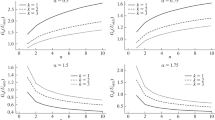Abstract
Let \(\{W_m\}{_{m\ge 1}}\) be the sequence of weak records from a discrete parent random variable, \(X\), supported on the non-negative integers. We obtain a new characterization of geometric distributions based on an additive property of weak records: \(X\) follows a geometric distribution if and only if for certain integers, \(n,\, s\ge 1, W_{n+s}\stackrel{d}{=}W_n+W^{\prime }_s\), with \(W^{\prime }_s\) independent of \(W_n\) and \(W^{\prime }_s\stackrel{d}{=} W_s\).
Similar content being viewed by others
References
Ahsanullah M (1995) Record statistics. Nova Sciences Publishers, Commack, New York
Ahsanullah M (2008) Some characteristic properties of weak records of geometric distributions. J Stat Theory Appl 7(1):81–92
Ahsanullah M, Hijab O (2007) Some characterizations of geometric distributions by weak records. In: Ahsanullah M, Raqab M (eds) Recent developments in ordered random variables, chapt 12. Nova Science Publishers, Inc., New York, pp 187–195
Aliev FA (1998) Characterization of distributions through weak records. J Appl Statist Sci 8:13–16
Aliev FA (1999) New characterization of discrete distributions through weak records. Theory Probab Appl 44:756–761
Arnold BC, Balakrishnan N, Nagaraja HN (1998) Records. Wiley, New York
Danielak K, Dembińska A (2007) Some characterizations of discrete distributions based on weak records. Statist Pap 48:479–489
Dembińska A (2007) A review on characterizations of discrete distributions based on records and kth records. Comm Statist Theory Methods 36:1381–1387
Dembińska A, López-Blázquez F (2005) A characterization of geometric distribution through kth weak records. Comm Statist Theory Methods 34:2345–2351
Hijab O, Ahsanullah M (2006) Weak records of geometric distributions and some characterizations. Pak J Stat 22(2):139–146
López-Blázquez F (2004) Linear prediction of weak records: the discrete case. Theory Probab Appl 48:718–723
López-Blázquez F, Wesołowski J (2001) Discrete distributions for which the regression of the first record on the second is linear. Test 10:121–131
López-Blázquez F, Salamanca-Miño B (2009) Random translation of records from geometric distributions. Comm Statist Theory Methods 38:2067–2077
Nevzorov VB (2001) Records: Mathematica Theory. Translations of mathematical monographs, vol. 194. American Mathematical Society, Providence
Stepanov AV (1993) A characterization theorem for weak records. Theory Probab Appl 38:762–764
Vervaat W (1973) Limit distributions of records from discrete distributions. Stochastic Process Appl 1:317–334
Wesołowski J, Ahsanullah M (2001) Linearity of regression for non-adjacent weak records. Statistica Sinica 11:39–52
Wesołowski J, López-Blázquez F (2004) Linearity of regression for the past weak and ordinary records. Statistics 38:457–464
Acknowledgments
This research has been supported by Grants MTM2010-16949 and MTM2010-19576-C02-02 of Ministerio de Educación y Ciencia, Spain and FQM331, FQM355 and FQM5849 of Junta de Andalucía. We also thank the referees for their helpful comments.
Author information
Authors and Affiliations
Corresponding author
Additional information
Communicated by George Weiss.
Appendix: Some results about combinatorial numbers
Appendix: Some results about combinatorial numbers
In the proof of our main result we used some properties of the combinatorial numbers. We collect these properties in this section.
Let \(a\) and \(b\) be non-negative integers. If \(a\ge b, \left(\begin{array}{l} a\\ b \end{array}\right)=a!/(b!(a-b)!)\). If \(a<b, \left(\begin{array}{l} a\\ b \end{array}\right)=0\).
Lemma 1
Let \(a, b, c\) and \(k\) be non-negative integers. Then
-
(i)
If \(b\ge c\),
$$\begin{aligned} \sum _{j=0}^c \left(\begin{array}{c} a+j\\ j \end{array}\right) \left(\begin{array}{l} b-j\\ c-j \end{array}\right) = \left(\begin{array}{c} a+b+1\\ c \end{array}\right). \end{aligned}$$(36) -
(ii)
If \(a\ge 1\)
$$\begin{aligned} \left(\begin{array}{l} k+a\\ k+1 \end{array}\right) =\sum _{j=0}^{a-1} \left(\begin{array}{c} k+a-j-1\\ k \end{array}\right). \end{aligned}$$(37) -
(iii)
For all \(k\ge 0\),
$$\begin{aligned} \left(\begin{array}{c} k+a+b-j\\ k+1 \end{array}\right) -\left(\begin{array}{c} k+a-j\\ k+1 \end{array}\right) -\left(\begin{array}{c} k+b-j\\ k+1 \end{array}\right) \ge 0,\quad j\ge 0. \end{aligned}$$(38)
Proof
-
(i)
For any \(\alpha \ge 0, (1-z)^{-(\alpha +1)}=\sum _{j=0}^\infty \left(\begin{array}{c} \alpha +j\\ j \end{array}\right) z^j, |z|<1\). Consider the identity
$$\begin{aligned} (1-z)^{-(a+1)}(1-z)^{-(b-c+1)}=(1-z)^{-(a+b-c+2)}, \quad |z|<1, \end{aligned}$$(39)expanding both sides of (39) and equating the coefficients of powers of degree \(k\ge 0\) in \(z,\) we obtain
$$\begin{aligned} \sum _{j=0}^k \left(\begin{array}{c} a+j\\ j \end{array}\right) \left(\begin{array}{c} b-c+k-j\\ k-j \end{array}\right) = \left(\begin{array}{c} a+b-c+k+1\\ k \end{array}\right), \end{aligned}$$(40) -
(ii)
It is not difficult to check by induction on \(a\) that
$$\begin{aligned} \left(\begin{array}{l} k+a\\ k+1 \end{array}\right) =\sum _{i=0}^{a-1} \left(\begin{array}{c} k+i\\ k \end{array}\right) ,\quad k\ge 0, \end{aligned}$$(41)and (37) follows from (41) with the change of indexes \(i=a-1-j\).
-
(iii)
By induction on \(k\). If \(k=0\) the result is straightforward. Suppose that the inequality is valid for certain \(k\ge 0\) and note that for any non-negative integers, \(\alpha , \beta ,\)
$$\begin{aligned} \left(\begin{array}{l} \alpha +1\\ \beta +1 \end{array}\right) =\frac{\alpha +1}{\beta +1} \left(\begin{array}{l} \alpha \\ \beta \end{array}\right) \end{aligned}$$(42)(this formula is trivially true if \(\alpha <\beta \)). Then, for any \(j\ge 0,\) using (42) and the hypothesis of induction,
$$\begin{aligned} \left(\begin{array}{c} k+1+a+b-j\\ k+2 \end{array}\right)&= \frac{k+1+a+b-j}{k+2} \left(\begin{array}{c} k+a+b-j\\ k+1 \end{array}\right)\\&\ge \frac{k+1+a+b-j}{k+2}\left\{ \left(\begin{array}{c} k+a-j\\ k+1 \end{array}\right) + \left(\begin{array}{c} k+b-j\\ k+1 \end{array}\right) \right\} \\&\ge \frac{k+1+a-j}{k+2} \left(\begin{array}{c} k+a-j\\ k+1 \end{array}\right)\\&+\frac{k+1+b-j}{k+2} \left(\begin{array}{c} k+b-j\\ k+1 \end{array}\right)\\&\ge \left(\begin{array}{c} k+1+a-j\\ k+2 \end{array}\right) + \left(\begin{array}{c} k+1+b-j\\ k+2 \end{array}\right). \end{aligned}$$\(\square \)
Rights and permissions
About this article
Cite this article
Castaño-Martínez, A., López-Blázquez, F. & Salamanca-Miño, B. An additive property of weak records from geometric distributions. Metrika 76, 449–458 (2013). https://doi.org/10.1007/s00184-012-0398-4
Received:
Published:
Issue Date:
DOI: https://doi.org/10.1007/s00184-012-0398-4



